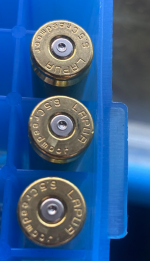Rifle is a Zermatt Arms TL3, PVA 18inch 1:8 twist barrell. I loaded 3 rounds each with below details:
Load 1: 3 Rounds with 43.4 grain H4350, 147 grain eldm, neck tension 0.004". Achieved MV 2715 fps with 6 SD, 0.5 MOA
Load 2: 3 rounds with 41.4 grain H4350, 147 grain eldm, neck tension 0.004". Achieved MV 2596 fps with 7 SD, 0.3 MOA
Please have a look at attached pictured and let me know if you see any pressure signs. Did not experience any heavy bolt lift. With these results, I am contemplating further reduction in charge weight. But will be great if people can give me some idea on how hot load 2 (41.4 grain) looks like.
thanks for all the help
PS: I am using 0.004" neck tension as this is new brass and I dont have an expander manderal to correct it. In Once fired brass I will correct neck tension to 0.002"
Load 1: 3 Rounds with 43.4 grain H4350, 147 grain eldm, neck tension 0.004". Achieved MV 2715 fps with 6 SD, 0.5 MOA
Load 2: 3 rounds with 41.4 grain H4350, 147 grain eldm, neck tension 0.004". Achieved MV 2596 fps with 7 SD, 0.3 MOA
Please have a look at attached pictured and let me know if you see any pressure signs. Did not experience any heavy bolt lift. With these results, I am contemplating further reduction in charge weight. But will be great if people can give me some idea on how hot load 2 (41.4 grain) looks like.
thanks for all the help
PS: I am using 0.004" neck tension as this is new brass and I dont have an expander manderal to correct it. In Once fired brass I will correct neck tension to 0.002"


